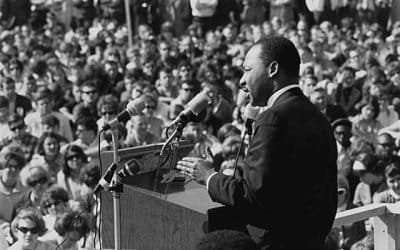“The Passion of the Christ,” a movie that highlights Jesus’ suffering and crucifixion, has met with both strong praise and heated criticism. Yet virtually no one has condemned this movie for championing the anti-life ideas fundamental to religion.
By contrasting the ethical codes of two moral ideals — Jesus of the Bible and “The Passion,” symbolized by the Crucifix, and architect Howard Roark of “The Fountainhead,” a novel by philosopher Ayn Rand, symbolized by his stance atop his skyscraper — we can understand why this condemnation is needed.
Christianity preaches that the ideal moral man sacrificed his life for a human race tainted by original sin. Christians primarily feel guilt for both their corrupt human nature and their Savior’s supreme sacrifice. In reality, however, man’s moral character is formed, not by some alleged inborn immoralities, but by his knowledge of right and wrong and his chosen actions.
Nevertheless, Jesus loves and forgives you despite your sins. Christians are commanded to love others unconditionally, and to turn the other cheek in forgiveness, even if the subjects we must love and forgive committed murder.
But when good and evil men are treated equally, evil becomes empowered. A murderer, for example, gains an unearned moral sanction, and subsequently the innocent, good man is morally impotent to defend against and defeat evil. Jesus’ twisted, bloodied body nailed to the Cross — after he sacrificed himself to his torturers and to men less virtuous than himself — embodies this sanction of evil.
The historical examples of this morality, basic to all religions — in which men either sacrifice themselves to other or others to themselves — are legion, from the Christians who burned heretics at the stake throughout the Dark and Middle Ages to the Islamic terrorists who incinerated “infidels” by crashing planes into skyscrapers.
Conversely, Howard Roark lives by rational self-interest in America, a secular land that champions the selfish pursuit of happiness. Roark is Ayn Rand’s first significant characterization of Objectivism, her philosophy that identifies each man’s right to live for his own sake. Rationality and productivity being his highest virtues, Roark pursues a career in architecture, and with ironclad individualism and integrity he achieves his top values: self-esteem, happiness and pride. Roark judges and trades with, loves and forgives, befriends and marries other individuals only to the extent they share his values.
Fiercely independent, Roark chooses a career he is most passionate about and that makes him happiest. By contrast, his self-sacrificing counterpart, Peter Keating, wants to be a painter, but pursues architecture instead to please his mother. Midway through “The Fountainhead,” the unprincipled Keating has a thriving career building his secondhand structures, while the principled Roark is an unemployed innovative architect laboring in a granite quarry.
Unlike Jesus, however, Roark lends no significance to his suffering and pain. He focuses instead on pursuing his career passionately and uncompromisingly. Later, when other architects add classical features to one of his modern buildings, compromising the integrity of his work, Roark dynamites the structure, and faces trial for this act. In his courtroom speech, he demonstrates to the jury the life-advancing values born of rationality and selfishness, and they acquit him. Ultimately, the morally bankrupt Keating becomes spiritually broken, and Roark achieves his values.
The 1949 movie of “The Fountainhead” stylizes this resolution expertly, as Roark (played by Gary Cooper) stands erect against whipping winds atop his Wynand Building, the world’s tallest structure, with his hands on his hips. Christianity condemns this pride — the crowning emotional achievement of a man devoted to rational values — as a deadly sin.
Miss Rand created the fictitious Roark based on the artistic principle of what men “might be and ought to be” — meaning individualist like him — Christopher Columbus, Galileo, Thomas Jefferson, Frank Lloyd Wright, Bill Gates — can and do exist. Roark embodies what she coined the benevolent universe premise, “the conviction that joy, exaltation, beauty, greatness, heroism, all the supreme, uplifting values of man’s existence on earth, are the meaning of life — not the pain or ugliness he may encounter.”
In contrast, Jesus in “The Passion” embodies, as one reviewer wrote, “religion in its fundamental sense”; the theme “that suffering, not joy, is man’s proper fate.”
Criticism of “The Passion” should properly center on the fact that Christianity continues to sell its essentially guilt-inducing, self-sacrificial morality of pain, suffering and death as life-affirming, while it makes man’s mythical inborn depravity the scapegoat for the immoralities religion generates and sanctions. Meanwhile, Objectivism is, as Ayn Rand described it, “a philosophy for living on earth,” but remains controversial.
This controversy must end, with self-sacrifice understood for the death-worship it is, and rational self-interest as the foundation for human achievement and happiness.



